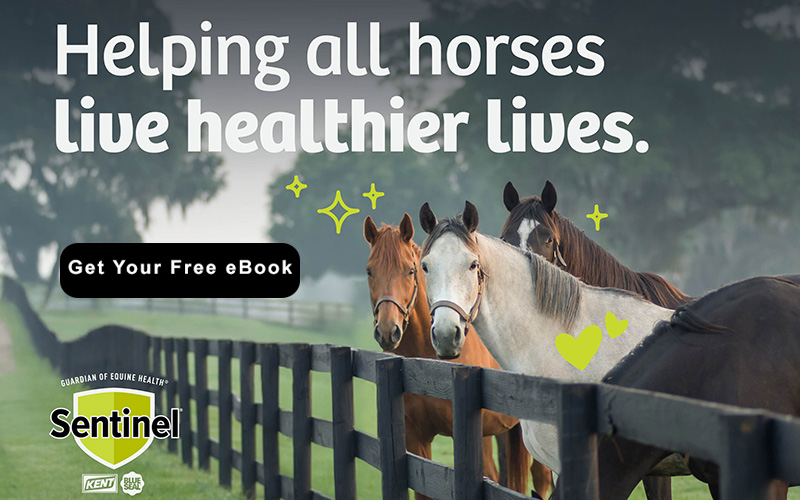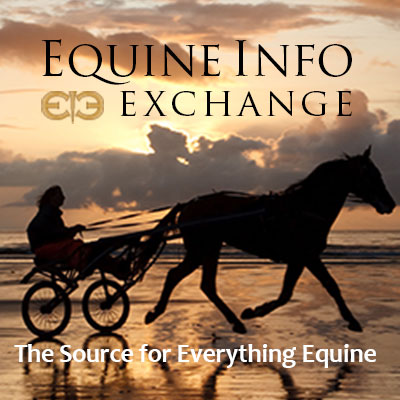Health & Education
We all want the best care possible for our horses. The Heath & Education section covers both Learning Institutions, Organizations as well as many sources for equine assistance including Veterinarians and Farriers.
For those who want a to formally study horses, the Education section includes College Riding, Equine Studies, and Veterinary Schools. Learn about the wide variety of horses in the Horse Breeds section. Supplements and Treatments Therapy are also included in the section.
Everyone can learn from Fine Art and there are some specialty Museums that might surprise you.
Horses as a therapy partner enrich the lives of the disabled. These facilities are listed in our Therapeutic Riding section. To help children and young adults build confidence and grow emotionally, please see the resources available on the Youth Outreach page.
Looking for a place to keep your horse? You can find it in the Horse Boarding section. Traveling? Find a Shipping company or Horse Sitting service if your horse is staying home!
Want to stay up to date with the latest training clinics or professional conferences? Take a look at our Calendar of Events for Health & Education for the dates and locations of upcoming events.
Do we need to add more? Please use the useful feedback link and let us know!
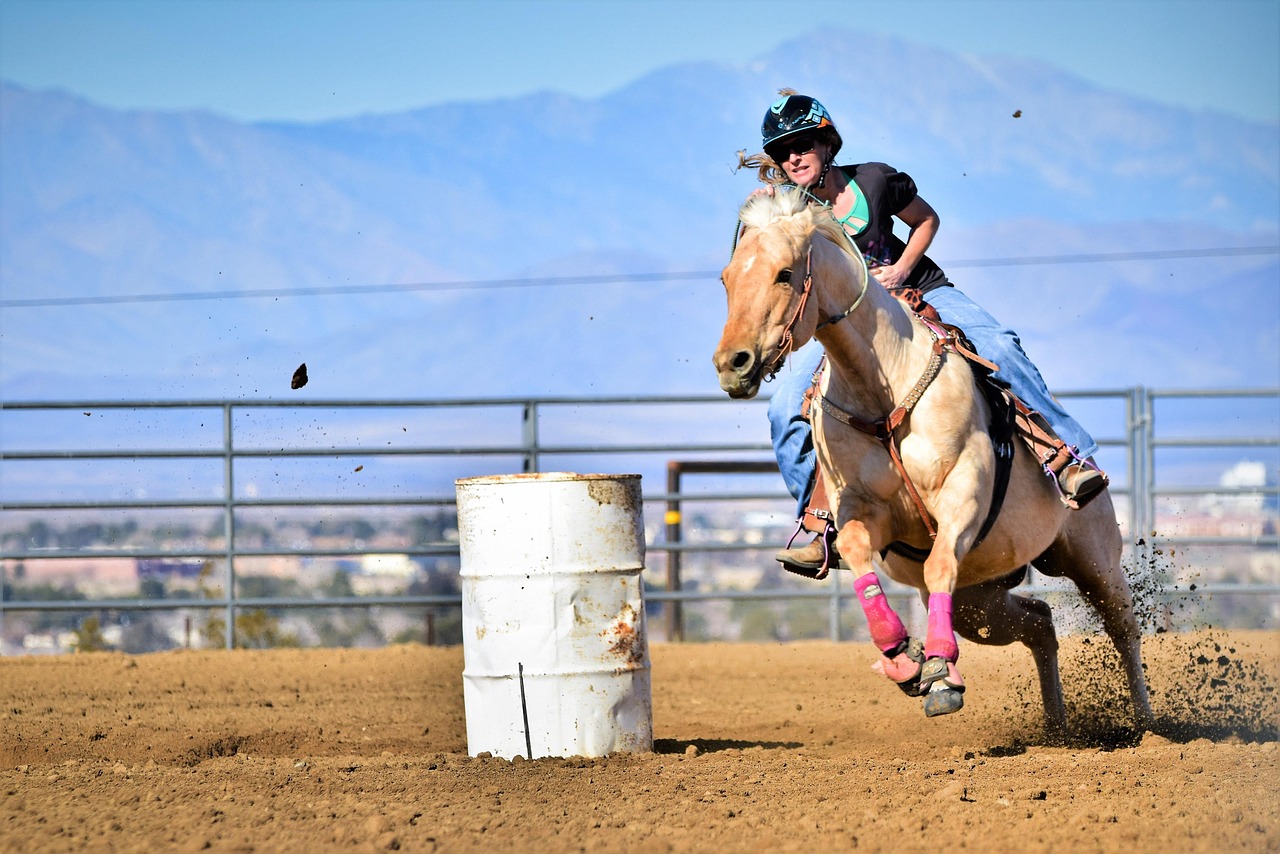
The American Quarter Horse is considered the most popular horse breed due to its extraordinary versatility, calm temperament, and historic role in the American West. These horses excel in a wide range of activities, from demanding ranch work and high-speed rodeo events to recreational trail riding and show competitions, making it a reliable and adaptable horse for both professional and family use. The American Quarter Horse Association (AQHA), which is the world's largest equine breed registry, has registered over six million horses since 1940.
Versatility and athleticism
American Quarter Horses are "all-rounders" that can excel in a wide array of disciplines, making them a practical choice for many owners.
- Western events: Their muscular and compact build is perfectly suited for rodeo events like barrel racing, roping, and cutting, where explosive speed and agility are essential.
- Ranch work: With a natural "cow sense," they are invaluable for working with cattle, a tradition dating back to the ranches of the American West.
- Racing: True to their name, they are the fastest breed over a quarter-mile distance, with some clocking speeds up to 55 mph.
- English disciplines: Though famous for their Western abilities, they also compete successfully in English disciplines like jumping, dressage, and equitation.
- Recreational riding: Their dependable nature makes them a popular choice for pleasure riding and trail riding.
Calm and trainable temperament
Quarter Horses are known for their gentle and easygoing disposition, making them suitable for riders of all skill levels. This cooperative and intelligent nature makes them an ideal choice for a wide range of uses, from competitive show horses to quiet family companions.
Deep American historical roots
The breed's long history is closely linked to the development of the United States.
- Colonial beginnings: The breed traces its origin to the 1600s, when colonists bred imported English Thoroughbreds with native Spanish horses to produce a compact, swift equine.
- Western expansion: As settlers moved west, the Quarter Horse's speed and ability to work cattle cemented its place as the iconic horse of the cowboy and the open range. This legacy continues to resonate with many horse owners today.
Largest breed registry
The sheer numbers of registered Quarter Horses reflect the breed's popularity. As mentioned, the American Quarter Horse Association (AQHA) is the largest horse breed registry in the world, with over six million horses in its registry. This large community also contributes to the breed's continued growth and recognition through shows, events, and youth programs.
For all of these reasons, we love Quarter Horses too! Learn about more Horse Breeds on EIE.
You can find more informative articles in our section on Recreation & Lifestyle. Take a look at our Curated Amazon Store for our selections in a wide variety of categories!
Interested in promoting your business or sharing content on EIE? Contact us at info@equineinfoexchange.com
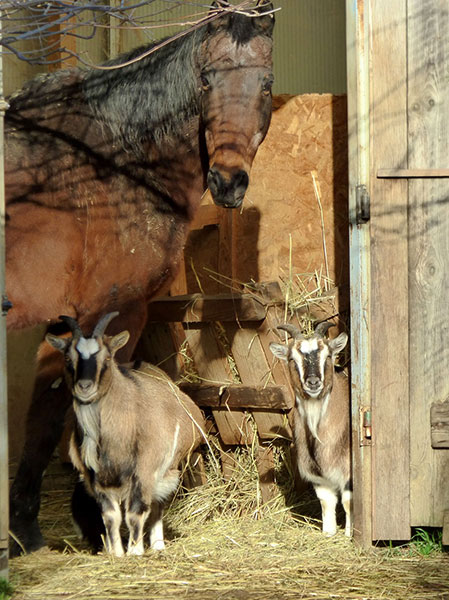
Goats are used as companions for horses primarily because of their calming presence, herd instincts, and cost-effectiveness compared to other horses. This practice is common in racehorse stables, where highly-strung and nervous horses can benefit from a goat's soothing company.
In fact, the phase, “Getting someone’s goat” is known to have racehorse roots!
One widely circulated story suggests that trainers would place a goat in the stall of a high-strung racehorse to keep it calm before a big race. Opposing trainers would sometimes steal the goat, hoping to upset the horse and cause it to perform poorly.
"Getting someone's goat," in this sense, meant intentionally causing a person or animal distress.
Calming influence
- Reduces stress: Horses are prey animals and feel safer in a herd. A goat can serve as a non-threatening and predictable "barn buddy" that reduces anxiety in a single or nervous horse. This can help curb nervous behaviors such as pacing, stall-walking, or cribbing (chewing on stall edges).
- Reliable companion: Goats tend to be steady and predictable, which can be comforting to horses, particularly young thoroughbreds in high-pressure training environments. The bond can become so strong that both animals may show signs of stress if they are separated.
Cost and convenience
- Lower cost: Keeping a goat is far less expensive than owning a second horse, which involves significant costs for food, veterinary care, and farrier work.
- Less space: For horse owners who only have enough space for one horse, a goat is a manageable addition that doesn't require a large extra pasture.
Herd animal instincts
- Natural bonding: Both horses and goats are herd animals, and when raised together, they tend to bond easily and quickly. They can become deeply attached and even protective of one another.
- Playful interaction: Goats are naturally sociable and playful creatures, which can provide entertaining and engaging company for a horse.
Pasture maintenance
- Complementary grazing: Goats are browsers, meaning they prefer to eat weeds, shrubs, and brush that horses, as grazers, typically ignore. This can help improve pasture quality by clearing out undesirable plants without competing with the horse for grass.
- Parasite control: Because horses and goats are susceptible to different internal parasites, they can safely graze together without increasing the risk of infection for either species.
Potential challenges
While often successful, using goats as horse companions is not without risks.
- Injury risk: A large horse could accidentally step on or kick a smaller goat, especially if they are not well-socialized or if the horse is territorial.
- Dietary needs: While they can share a pasture, horses and goats have different dietary needs. Goats can be sensitive to the copper content in some horse feeds, so it's important to feed them separately.
- Fencing requirements: Goats are notorious escape artists and require more secure fencing, such as woven-wire or electric fencing, than horses do.
We’ve seen many horses who welcomed a goat in their lives and it’s a way for a lonely or nervous horse to have some calm company!
You can find more informative articles in our section on Recreation & Lifestyle. Take a look at our Curated Amazon Store for our selections in a wide variety of categories!
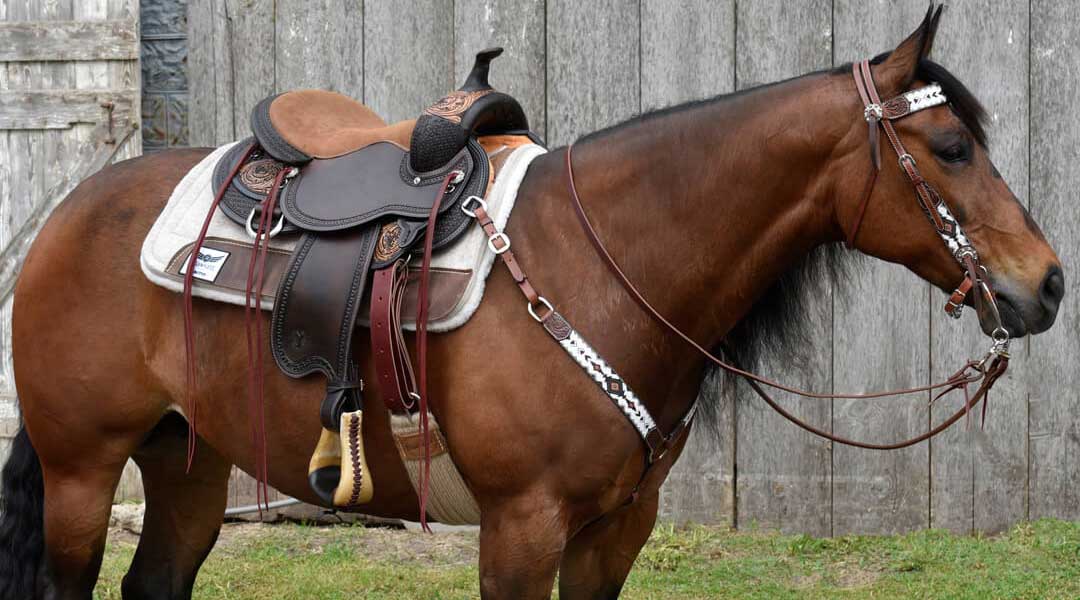
If your blue jeans were two sizes too small, it’s likely your body would show signs of (major) discomfort, such as pinching and red marks. Now, unless they’re the last pair to your name, you’re likely not wearing those jeans again, let alone tomorrow, the next day, or for days to come.
Now, imagine how your horse might feel, if he is consistently ridden in an improperly fitted saddle.
How Does Your Saddle Fit Your Horse?
Your horse’s comfort, happiness and your proper positioning as a rider all weighs on your saddle’s fit. An improper saddle fit causes your weight to be distributed unevenly, which can result in pressure points, rub marks, soreness, or the development of white saddle spots on your horse.
Monitor your horse’s attitude and behavior while riding, which can clue you in on a painful saddle fit, but keep in mind: some horses are more stoic than others. It’s best that you take a step back and take a close look at your horse while he is saddled to determine fit.
Your saddle fits just right if it sits level on your horse’s back and the bars of the tree do not pinch. The front of your saddle should be positioned behind your horse’s shoulder blade, allowing him freedom of movement.
Your saddle is too narrow if the front of the saddle sits high. When the saddle is sitting directly upon the horse’s withers, pinching can often occur.
Your saddle is too wide if the front of the saddle is low. This also results in pinching but at the top of the saddle’s bars. In this scenario, the gullet of the saddle may be too low and rest on your horse’s withers causing pain and discomfort.
Continue reading for additional guidance to help ensure you and your horse enjoys the most comfortable and secure ride possible.
What to Consider When Selecting a Saddle Pad
Selecting a saddle pad is an important decision that should not be based on look and color patterns alone. Some saddle pads are uniquely designed and contoured to fit your horse’s back immediately, relieve wither pressure and wick away sweat and moisture.
Be sure to avoid over-padding your horse, a common practice that can result in your saddle rolling and sliding more easily. Choose a saddle pad that offers your horse the support he needs. Shop saddle pads and blankets
How to Measure For a Cinch
For your saddle’s fit and proper positioning on your horse, it is important that your horse’s cinch fit well, too. In the video above, Professional’s Choice representative and professional rodeo cowboy, Brodie Poppino, shares how to properly measure and fit a cinch to your saddle.
Keep in mind, though: non-nylon cinches could stretch up to a full size, so based on your preference, consider the material before ordering a cinch for your horse.
What to Consider When Choosing a Cinch
When choosing a cinch for your horse and saddle, keep in mind there are two different types of cinches: Western cinches and roper cinches. A roper cinch is wide and contoured, so when they are cinched up and stop quickly, the weight is distributed more evenly over a wider area of the horse, reducing uncomfortable pressure on the horse’s abdomen.
When tightening your horse’s cinch for an everyday ride, consider how tightly you wear your belt, and offer your horse the same level of comfort. Overtightening a cinch can add pressure and discomfort for your horse before you even step into the stirrups. Shop cinches
Remember that the longevity of your saddle and tack all depends on how well it is cared for over the years. Cleaning and oiling your tack regularly helps to prevent cracking and protect the leather. Oiling your saddle also aids in a safer ride, as dry, cracked leather can result in breakage, which can potentially lead to a mishap and rider injury.
For safety, closely observe your tack and the quality of your leather pieces. Are they oiled and secure, without any sign of dry rot or cracking? If so, happy trails. If not, for the safety of your ride, it is time for repair or replacement. Shop leather care
This article originally appeared on Valley Vet and is published here with permission. Valley Vet Supply was founded in 1985 by veterinarians for people just like you - people who want the very best for their four-legged friends and livestock.
All photos courtesy of Valley Vet.
There are more informative articles in our section on Health & Education. While you're here, take a look at our Curated Amazon Store.
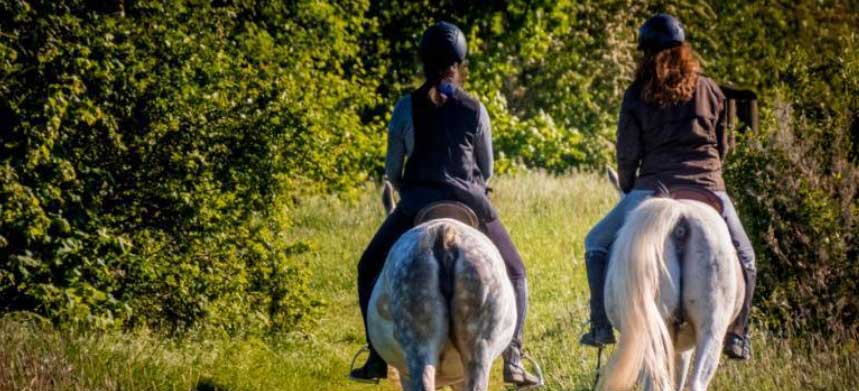
by Kentucky Equine Research Staff
Time, weather, and suitable facilities, rather than an owner’s knowledge and ability, were the three main factors limiting how much human-led exercise (HLE) a horse receives, said the authors of a U.K.-based survey exploring exercise as a means of weight management.
Many horses in the U.K. are maintained in “obesogenic environments,” defined as a setting that promotes gaining weight and one that is not conducive to weight loss. Even though horses are turned out for self-directed exercise (SDE), the pasture is too often nutrient-rich. As a result, horses get the benefits of turnout, including free movement, socialization, and grazing, but overconsume calories. Obesity is therefore common, and 40% of the 804 survey respondents admitted that their horses were either overweight or obese.
“This number is probably much higher than suspected, as previous research found that owners frequently underestimate their horse’s weight and body condition,” explained Ashley Fowler, Ph.D., a nutritionist for Kentucky Equine Research.
Obesity is a welfare issue because horses are at risk of developing osteoarthritis, laminitis, and metabolic problems.
Traditional means of managing obesity center on nutrition, primarily reducing dietary intake by restricting grazing and maintaining horses in individual stalls. This approach breaches the three “f’s” of equine welfare: freedom, friends, and forage.
“Instead of solely focusing on nutrient restriction, another approach to weight management is increasing energy expenditure either by HLE including longeing and riding or encouraging voluntary movement (SDE) during turnout,” Fowler said.
Based on the survey, most owners indicated that their horses had daily turnout even in the winter. The bulk of the horses also engaged in HLE, primarily hacking or flatwork three to five times per week.
“The top three barriers to HLE were weather, time, and the availability of suitable facilities in which to exercise,” Fowler indicated.
But even with HLE, horses were believed to be overweight or obese because exercises were low-intensity and “unable to neutralize the obesity risk promoted by grass-rich environments,” stated the survey authors.
While owners indicated that they realized exercise was important in managing obesity, they felt increasing SDE rather than HLE would be a more realistic option due to lack of time combined with weather and lack of suitable facilities in which to exercise their horses. The researchers then suggested “track systems” for improving SDE. These are low- or no-grass tracks built around the perimeter of a field. Resources are then distributed throughout the track to promote movement.
Even though this study was conducted in the U.K., research on horses in the U.S. has also indicated a high prevalence of obesity in the equine population. Further, one U.S. study found horse owners also felt that caring for overweight horses increased time and labor input.**
As stated by the researchers, exercise plays a vital role in weight management, reducing the risk of insulin dysregulation, a key feature of equine metabolic syndrome. Nonetheless, dietary restriction still plays a key role in weight management, and Fowler reminds owners the importance of forage.
“Horses require at least 1.5% of their body weight in forage each day to support a healthy gastrointestinal tract and to minimize the chance of developing equine gastric ulcer syndrome,” she said. “Even though overweight horses require a reduced-calorie diet, they still need to be fed sufficient vitamins and minerals. Including a ration balancer or vitamin-mineral supplement can help achieve this goal without overproviding calories.
Reprinted courtesy of Kentucky Equine Research. Kentucky Equine Research is an international equine nutrition, research, and consultation company serving horse owners and the feed industry. Our goals are to advance the industry's knowledge of equine nutrition and exercise physiology, apply that knowledge to produce healthier, more athletic horses, and support the nutritional care of all horses throughout their lives. Learn more at Kentucky Equine Research.
There a more informative articles in our section on Health & Education. While you're here be sure to visit our Curated Amazon Store.
*Naydani, C.J., and T. Coombs. 2025. Exercise as a welfare strategy? Insights from horse (Equus caballus) owners in the UK. Animal Welfare. 34:e14.
**Jaqueth, A.L., M.E. Iwaniuk, and A.O. Burk. 2018. Characterization of the prevalence and management of over-conditioned ponies and horses in Maryland. Journal of Equine Veterinary Science 68:26-32.
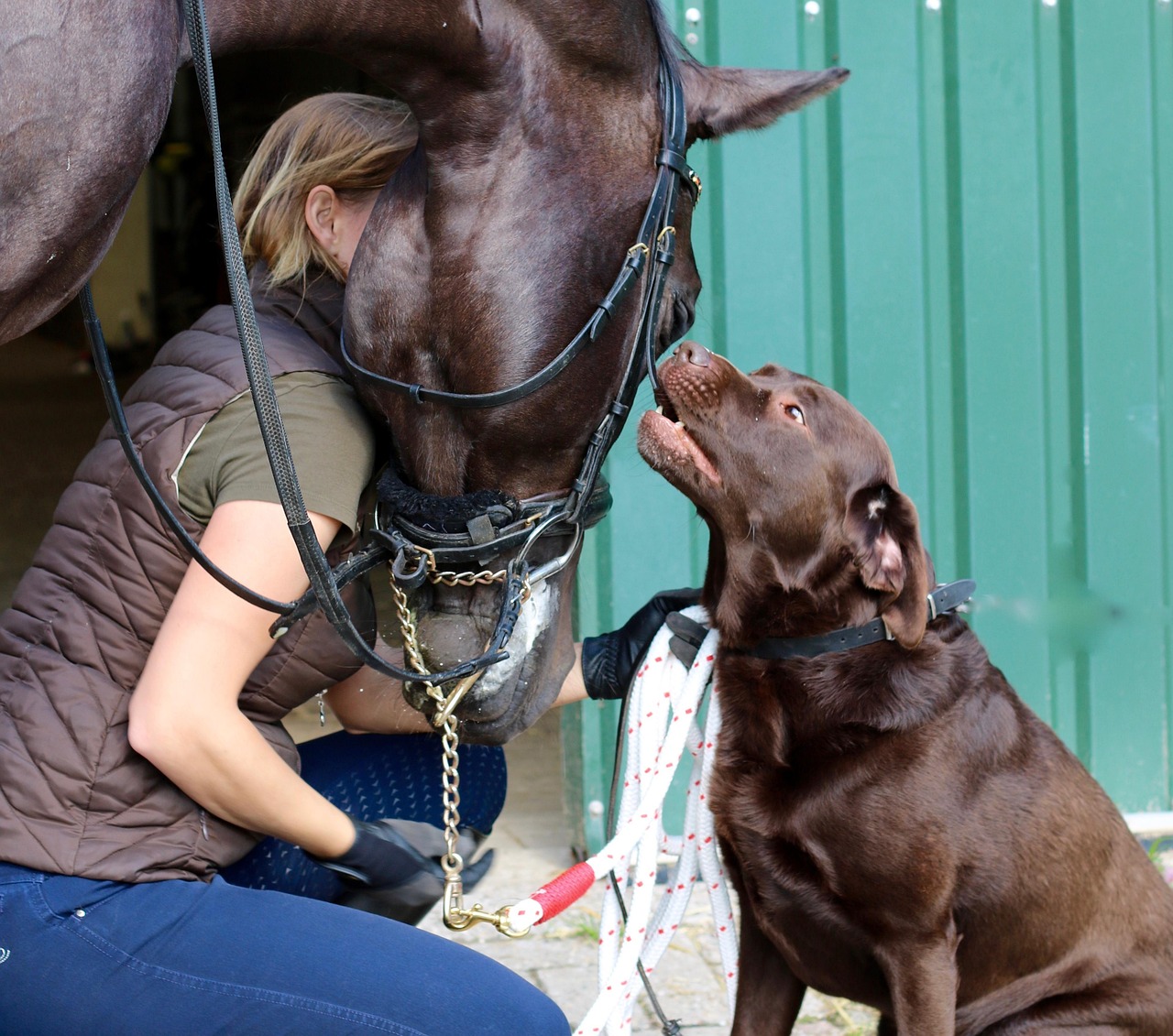
A dog's dental health is much more than a cosmetic concern; it is a critical component of their overall well-being and longevity. Neglected oral hygiene in canines can lead to painful conditions, such as periodontal disease, and even more severe, systemic health problems affecting major organs. While traditional brushing is a gold standard, consider using a dog dental powder for your pet! Dog dental powders have emerged as a convenient and effective supplement to help owners combat plaque and tartar buildup. These powders, added directly to a dog's food, offer a non-invasive solution for promoting oral health, especially for those dogs who resist having their teeth brushed.
The critical importance of canine oral health
Just as with humans, a dog's mouth is a breeding ground for bacteria. When these bacteria combine with food particles and saliva, they form plaque, a sticky, colorless film on the teeth. If plaque is not removed, it hardens into tartar, or dental calculus, which creates a rough surface for even more bacteria to accumulate. The accumulation of plaque and tartar is the primary cause of periodontal disease, a progressive condition that can wreak havoc on a dog's health.
Periodontal disease: The silent epidemic
Periodontal disease is the most common dental condition in dogs, with up to 80% of dogs showing signs by age three. It progresses in four stages, ranging from mild gingivitis to advanced periodontitis with significant bone and tissue loss around the teeth.
- Stage 1 (Gingivitis): The gums become red, swollen, and may bleed easily. At this stage, the condition is reversible with proper veterinary dental care.
- Stage 2 (Early Periodontitis): The supporting structures of the teeth, including the bone, start to become compromised.
- Stages 3 & 4 (Moderate to Advanced Periodontitis): The damage becomes irreversible. There is significant bone loss, gum recession, and a high risk of tooth loss.
Beyond the mouth: Systemic health risks
The consequences of untreated periodontal disease extend far beyond the oral cavity. The bacteria from a dog's mouth can enter the bloodstream and spread throughout the body, posing a serious threat to vital organs. Studies have linked advanced dental disease in dogs to microscopic changes in the kidneys, liver, and heart muscle. In fact, poor oral hygiene has been shown to potentially shorten a dog's lifespan by several years.
Dog dental powder: An easy and effective solution
For many pet owners, daily tooth brushing is a challenge. A dog's resistance or anxiety can make the process stressful for both parties. This is where dental powder provides a valuable alternative or complement to other oral care routines.
What is dog dental powder?
Dog dental powder is a dietary supplement designed to support oral hygiene from the inside out. It is a finely textured powder, typically made from natural ingredients like brown algae (Ascophyllum nodosum), cellulase, kelp, probiotics, and green tea extracts. It is simply sprinkled onto a dog's food once a day, where it mixes with the saliva and is ingested.
How does dental powder work?
The effectiveness of dental powder comes from its active ingredients, which work systemically to combat plaque and tartar. For example, the specific kelp found in some formulas is absorbed into the bloodstream and helps to reduce plaque and soften existing tartar deposits. Other ingredients, such as probiotics, target the bacteria that cause bad breath and can neutralize the compounds responsible for foul odor.
Key benefits of using dental powder
- Ease of use: The primary advantage of dental powder is its simplicity. Pet owners who struggle with brushing can easily incorporate this into their dog's daily feeding routine, eliminating the stress and struggle of a difficult task.
- Targets hard-to-reach areas: Unlike brushing, which can miss certain areas, dental powder's active ingredients work systemically, reaching all surfaces of the teeth and gums. This is particularly beneficial for hard-to-reach molars.
- Reduces plaque and tartar: Consistent daily use can significantly reduce and control plaque and tartar buildup over time. While results are not instant, many owners report seeing improvement within a few weeks to months.
- Freshens breath: Many dental powders contain ingredients like mint or green tea extract that help to freshen your dog's breath by tackling the odor-causing bacteria at the source.
- Supports overall oral health: By maintaining a healthy bacterial balance in the mouth, dental powder promotes healthy teeth and gums and can help prevent the onset of more serious conditions.
Combining dental powder with other care methods
It's important to understand that dental powder is not a replacement for professional veterinary dental care or brushing, especially for dogs with pre-existing or advanced dental disease. Instead, it should be part of a comprehensive oral hygiene plan.
- Routine vet check-ups: Annual or bi-annual dental check-ups with your veterinarian are essential for catching any problems early. Dental X-rays can reveal issues below the gumline that aren't visible to the naked eye.
- Professional cleanings: For dogs with moderate to severe tartar buildup, a professional dental cleaning under anesthesia is necessary to remove deposits from below the gumline and treat existing disease.
- Other home care options: In addition to dental powder, dental chews, water additives, and specialized dental diets can all contribute to better oral health.
Choosing and using dog dental powder
With a variety of products on the market, it's important to choose a high-quality dental powder that is both safe and effective for your dog.
What to look for
- VOHC-approved products: The Veterinary Oral Health Council (VOHC) awards a seal of acceptance to products that meet pre-set standards of plaque and tartar retardation. Checking for this seal is a good way to ensure a product is scientifically proven to be beneficial.
- Natural and safe ingredients: Opt for powders with natural, food-grade ingredients and avoid those with artificial additives or chemicals. Always check the ingredient list for potential allergens, especially if your dog has sensitivities.
- Positive reviews: Reading reviews from other pet owners and veterinary professionals can provide insight into a product's real-world effectiveness.
How to use dental powder effectively
- Follow instructions: Always adhere to the product's specific dosing instructions based on your dog's size. Consistent daily use is crucial for the powder to work effectively.
- Mix with food: Sprinkle the recommended amount of powder directly onto your dog's wet food. If your dog eats dry kibble, you can add a little warm water or broth to help the powder adhere to the food.
- Be patient: It can take several weeks or months to see visible results, especially for tartar reduction. Continued, consistent use is key.
Understanding the risks and limitations
While dental powder is a convenient option, it is not a cure-all and has limitations.
Not a replacement for veterinary care
Dental powder cannot reverse advanced periodontal disease, remove existing significant tartar buildup, or treat tooth infections or abscesses. These conditions require professional veterinary intervention, which often includes anesthesia, dental X-rays, scaling, and polishing.
Anesthesia-free dental cleaning concerns
Some grooming facilities and pet stores offer anesthesia-free dental cleanings. These procedures are not recommended by the American Veterinary Dental College (AVDC) because they are largely cosmetic and do not address the crucial areas below the gumline where periodontal disease takes hold. Furthermore, a dog's stress levels and the risk of injury are high during these non-anesthetic procedures.
Conclusion
The importance of a dog's oral health cannot be overstated. It directly impacts their comfort, happiness, and overall lifespan. While professional veterinary cleanings and at-home brushing remain the cornerstones of good dental care, dog dental powders offer a modern, low-stress, and effective supplement to this routine. By understanding the signs of dental disease, embracing preventive care, and incorporating easy-to-use products like dental powder, pet owners can take a proactive and compassionate approach to ensuring their furry companions enjoy a lifetime of healthy, happy smiles.
There are more interesting articles in our section on Health & Education.
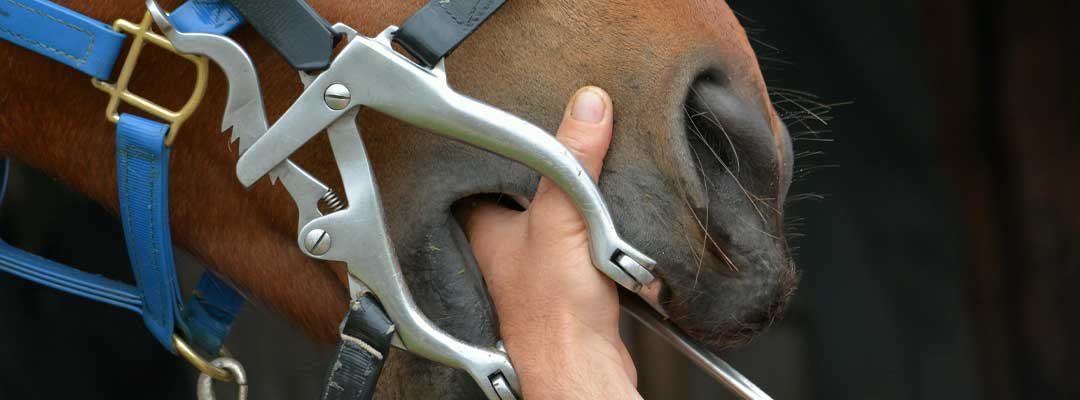
Caring for your horse's teeth through regular dental floats with a veterinarian can keep them on their best behavior.
“Could dental pain be the culprit for your horse’s behavioral problems?” asked Jeff Hall, DVM, senior equine technical services veterinarian with Zoetis.
A study published in the Journal of Equine Veterinary Science established a link between common equine behavior problems and abscessed cheek teeth. Periapical infections or abscessed cheek teeth are common in horses and will usually induce pain that is displayed in your horse’s behavior. According to the research, half of the cases of periapical infections were diagnosed during routine dental examinations, indicating that horse owners were unaware of the association between undesirable behavioral patterns of their horses and dental pain.
Behavioral Problems Linked to Tooth Pain
Common behavioral signs associated with cheek teeth abscesses fall into three main categories.
Eating and drinking
- Eating slowly or taking frequent pauses while eating hay
- Turning his head while eating or dropping hay or grain from his mouth
- Dipping hay in water or avoiding drinking cold water
Bit-related
- Evading the bit
- Headshaking, lolling tongue or opening his mouth when ridden and/or driven with a bit
- Rein contact worse on one side of the mouth
- Resistance to bridling
General
- Withdrawn, intense stare, aggressive behavior or self-harm to his head
- Avoiding social interaction with other horses and people
- Bad-smelling breath
- Poor performance, such as a decline in athletic ability
If your horse is expressing any of these behavioral signs, work with your equine veterinarian to conduct an annual oral and dental examination. Depending on your horse’s age, level of performance and overall condition of the teeth, additional examinations throughout the year may be needed.
What to Expect During a Dental Exam
“I find that horse owners are sometimes hesitate to schedule annual dental exams because they are unsure about what goes into an exam and what their horse will experience,” Dr. Hall said. “Dental exams are a safe, routine procedure that should be conducted by your veterinarian proactively every year.”
A thorough dental exam can take between 10 to 30 minutes and includes:
- An assessment of external structures of the horse’s head and soft tissues (e.g., lips, cheeks and lymph nodes)
- An examination of internal structures (e.g., tongue, palate, gums and cheeks)
- The visualization and palpation of teeth
During examination, veterinarians use a full mouth speculum. A full mouth speculum is a piece of equipment that fits onto a horse’s head, similar to a bridle, with mouth plates that fit between the front teeth to hold a horse’s mouth open. This allows for a more complete visualization and palpation of most aspects of the teeth.
Equine dental care, horse vaccinations and horse wormers all play an important role in their overall health and wellness.
About the author: This content was originally provided by Zoetis, and Jeff Hall, DVM, senior equine technical services veterinarian for Zoetis, with minor additions included from Valley Vet Supply.
This article originally appeared on Valley Vet and is published here with permission. Valley Vet Supply was founded in 1985 by veterinarians for people just like you - people who want the very best for their four-legged friends and livestock.
All photos courtesy of Valley Vet.
There are more informative articles in our section on Health & Education. While you're here, take a look at our Curated Amazon Store.
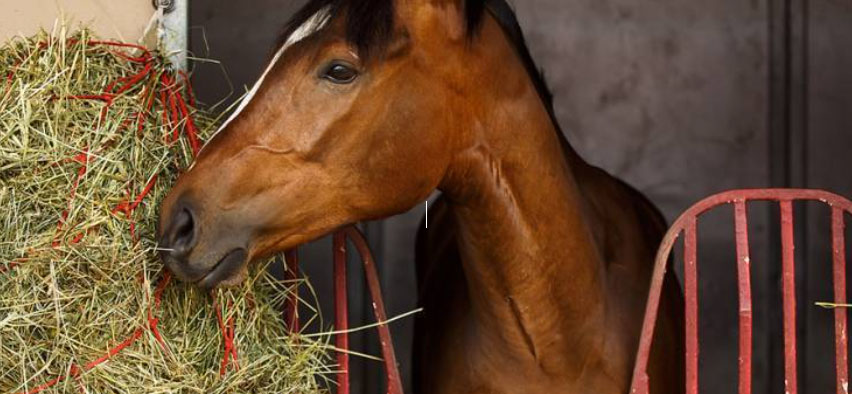
by Kentucky Equine Research Staff
Many performance horses are exercised at sun-up or earlier. Think about racehorses in training or show horses schooling before early-morning classes. The horses are pulled from their stalls, groomed, and tacked up; trainers and riders discuss the training plan for this daybreak bout of exercise. But does the groom, rider, or trainer think about the horse’s gastric well-being at that time? Maybe, maybe not.
When horses are exercised on an empty stomach, gastric acid splashes onto the squamous, or upper, portion of the stomach. Repeated exposure of gastric acid to this sensitive tissue can increase the risk of gastric ulcers. Prolonging hay consumption into the early morning hours can help protect performance horses from these ulcers. But when do horses eat during the night? Do they consume more hay before or after midnight?
To better understand nighttime feeding patterns, scientists at Kentucky Equine Research recorded horse behavior using two technologies: chewing halters and overhead cameras. They presented hay in various ways (one hay net or two and hay nets in different positions) to determine whether these configurations affected intake behavior.
The researchers outfitted six horses with chewing halters from 7:00 p.m. to 7:00 a.m. and fed them hay equal to about 1.26% of their body weight while stalled. In the first phase of the study, they placed hay in either one hay net or split the hay between two hay nets, positioning the top of each net parallel to the horses’ withers. In the second phase, they tested two positions of hay nets. One treatment included a hay net at withers height, and the second treatment involved a hay net placed much lower, nearly at ground level.
The chewing halters allowed the team to measure how long the horses spent chewing throughout the night, while the overhead cameras revealed when the hay nets became empty.
“Offering hay in different configurations—one net or two, hay net hung high or low—did not affect time spent eating overnight when a limited amount of hay was offered, as it was in this study,” said Ashley Fowler, Ph.D., director of research at Kentucky Equine Research. Most horses steadily consumed their allotted amount of hay until it was gone, with few horses taking significant breaks from eating.
In this study, the researchers stalled the horses to allow easy camera monitoring. Horses in other living situations may benefit from multiple feeding stations. According to Fowler, “We did not observe any advantage to hanging two hay nets instead of one in this study. In larger enclosures, such as dry lots, using multiple hay nets may encourage horses to walk between foraging locations. Horses that need to lose weight may benefit from increased movement.” Even more movement can be encouraged by placing water sources far from forage stations.
Fowler and her colleagues at Kentucky Equine Research are fine-tuning a follow-up study that will allow free-choice access to hay. “If horses are given free access to hay, we believe they will take more breaks during the night to rest, and there may be short bouts of eating rather than one long eating period, as seen in this study,” she said.
Reprinted courtesy of Kentucky Equine Research. Kentucky Equine Research is an international equine nutrition, research, and consultation company serving horse owners and the feed industry. Our goals are to advance the industry's knowledge of equine nutrition and exercise physiology, apply that knowledge to produce healthier, more athletic horses, and support the nutritional care of all horses throughout their lives. Learn more at Kentucky Equine Research.
There a more informative articles in our section on Health & Education. While you're here be sure to visit our Curated Amazon Store.
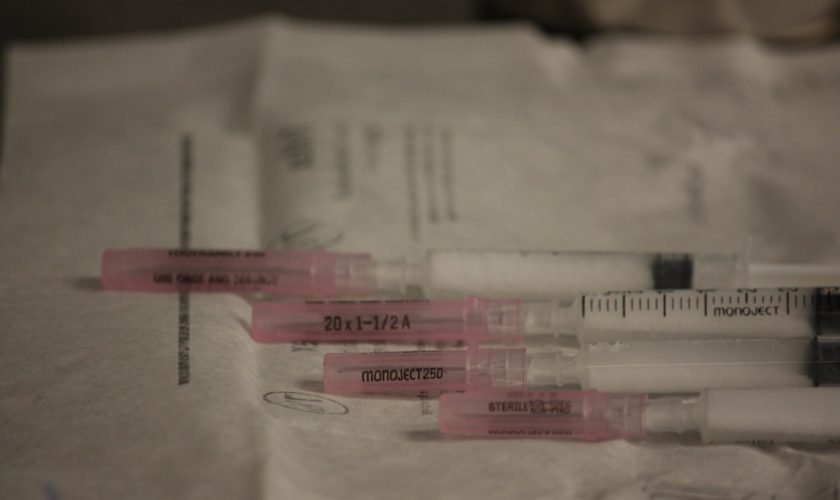
by Kristin Pitzer
Western performance horse riders generally enjoy showing off what their horses can do by traveling to events and competing against others that love their sport. At bigger shows, this often means that people and horses from all around the country must come together under one roof, sharing cross ties, wash racks, tie rings, etc. When your horse is around other horses, though, it is possible for it to be exposed to diseases that it wouldn’t have picked up in its home environment.
This is where equine vaccines come in. Vaccines help prepare the immune system to respond quickly when a horse is exposed to an infectious agent. While they don’t guarantee complete prevention, vaccines can lessen symptoms and help keep from spreading highly contagious diseases.
Quarter Horse News asked Geneve Dundas, DVM, who owns Dundas Veterinary Services PLLC in Fort Worth, Texas, for recommendations on vaccinating horses, especially when preparing to haul to an event.
Vaccinate All Horses With Core Vaccines
According to American Association of Equine Practitioners (AAEP) guidelines, all horses should be immunized with four core vaccines each year: tetanus, West Nile Virus and Eastern and Western Equine Encephalomyelitis (EEE and WEE). Rabies is also considered a core vaccine in some parts of the country, depending on county regulations and rules.
Vaccinating horses against these diseases is important because your horse can become infected even if it never leaves its home property. WEE and EEE are primarily contracted through mosquitoes and ticks; rabies exposure occurs through the bite of an infected animal; tetanus is present in feces and abundant in the soil; and West Nile Virus is transmitted by mosquitoes from birds to horses. All four diseases are deadly, and vaccines are instrumental in preventing infection.
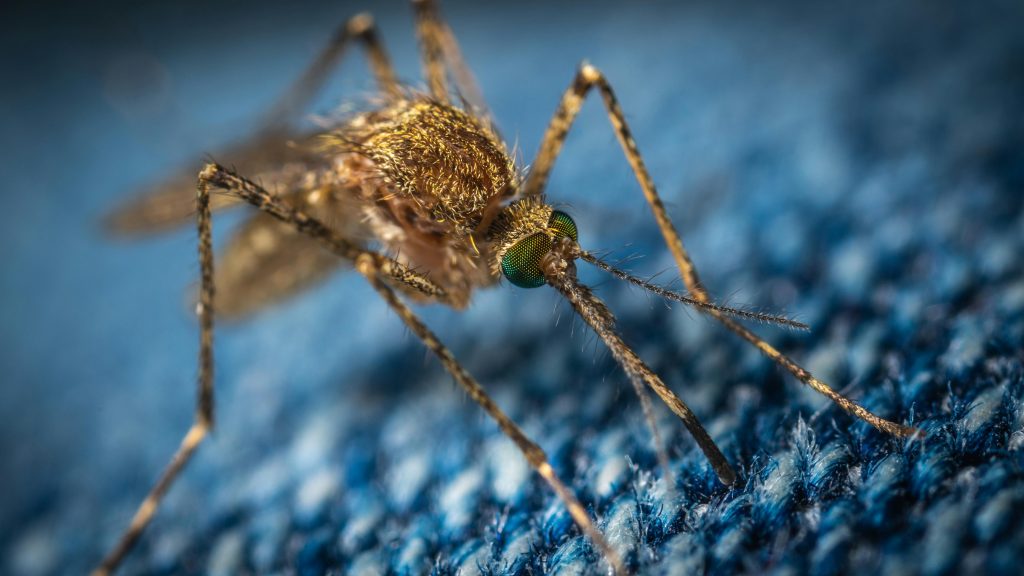
“These vaccines are necessary to aid these animals’ immune systems in fighting and modulating the severity of these diseases,” Dundas said. “Tetanus has an 80% mortality rate, EEE and WEE encephalitis are very devastating if not fatal, and rabies is fatal and communicable to humans. Some can recover from West Nile but often are no longer rideable, and severe cases result in patients that are a danger to themselves or others due to neurological symptoms.”
Take Extra Care With Show Horses
Even if your horse is vaccinated annually with the core vaccinations, you should ask your veterinarian about additional prevention if you’re planning to haul to shows. There are other highly-communicable diseases that can spread via horse-to-horse contact, and due to the layouts of stalls at showgrounds, many horses often share the same space. Hauling your horse can also stress its immune system, making it more susceptible to illness.
“Show horses travel a great deal and are exposed to many other horses, animals and environments,” Dundas said. “The stress of trailering, being stalled and showing means their immune systems are often fighting off a great deal of organisms, and stress can suppress the immune system. Vaccines aid them in staying healthy.”
One additional vaccine that is often mandatory for show horses is the flu/rhino vaccine, which protects against equine influenza and equine herpesvirus.
EHV Is Highly Contagious
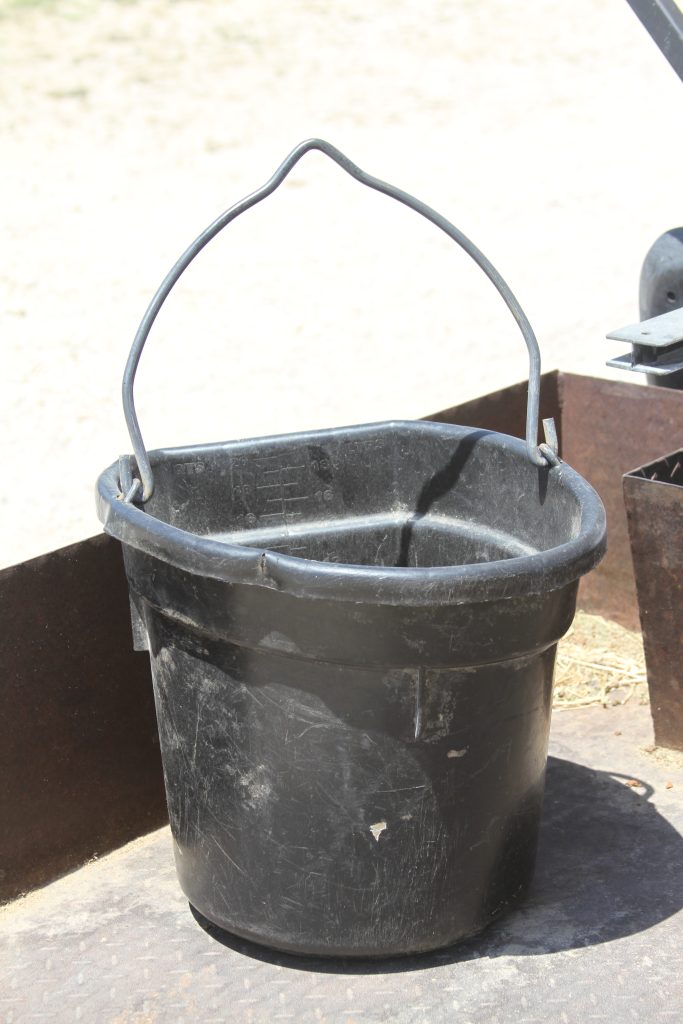
Equine herpesvirus, or EHV, is a DNA virus found in most horses. This family of viruses is named by numbers, and EHV-1, -3 and -4 pose the most health risks for domestic horses, according to the AAEP. Usually, infected horses see no serious side effects, but sometimes, for reasons unknown, one might develop a fatal neurological form called equine herpesvirus myeloencephalopathy.
EHV-1 and EHV-4 in particular are the most common species of EHV. EHV-1 can cause abortion, respiratory disease and neurologic disease, and EHV-4 can cause a nonfatal upper respiratory tract disease in foals. The viruses are spread by direct horse-to-horse contact via nasal secretions or through contact with physical objects that are contaminated.
Showgrounds can be a hotbed for EHV contagion: feed buckets, water buckets, grooming equipment, tack, trailers, and even your hands and clothing could all be contaminated if touched by a horse that is infected. The AAEP recommends that performance horses be vaccinated for EHV every six months, as vaccinated horses are more likely to produce a strong immune response without having clinical signs of the disease.
Flu Vaccines Should Also Be Given Every Six Months
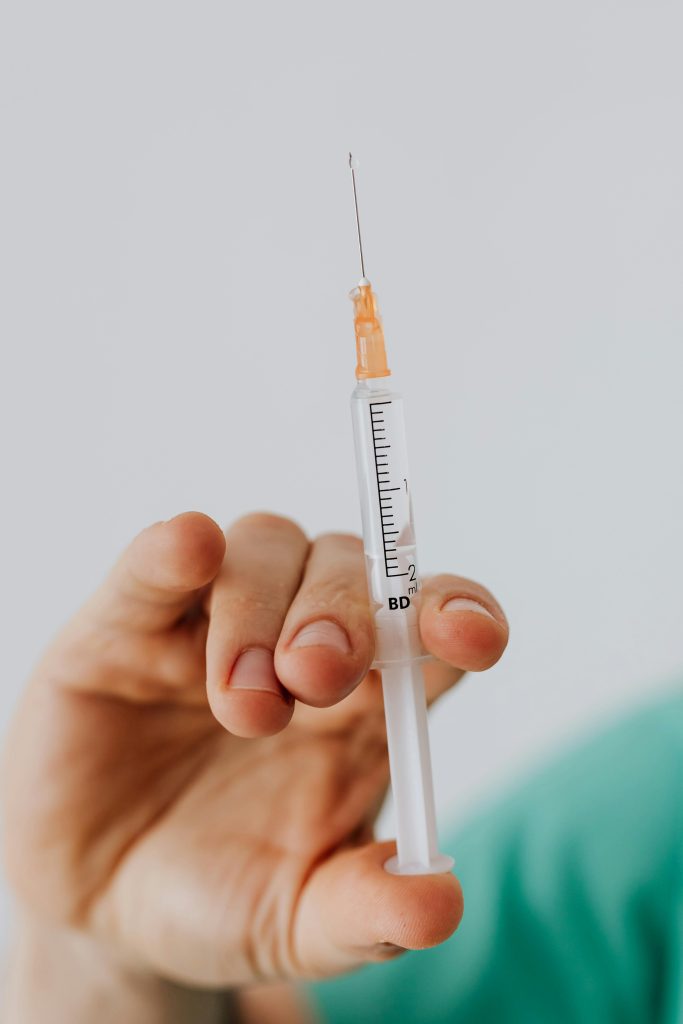
Equine influenza is also highly contagious and spreads via aerosolized droplets when an infected horse coughs. It can also survive on objects in the environment, much like EHV.
Equine influenza can cause respiratory disease, including fever, edema, enlarged lymph nodes and nasal discharge. Horses that are immunosuppressed, such as those that are on the road often hauling for World titles, can have an increased risk for infection and developing more severe symptoms.
Flu vaccines can offer protection against certain strains of equine influenza, but because the duration of that protection is limited, boosters should be given every six months. While some vaccines are given intramuscularly, there is also an intranasal vaccine that can achieve more rapid protection, which can be particularly useful in an equine influenza outbreak.
Take Additional Measures
Vaccinations are a good place to start your defense against communicable equine diseases, but there are other practices you should follow to keep your horse as safe and healthy as possible when on the road, Dundas said. For one, let your horse have as little contact with other horses as possible, especially when using communal facilities and equipment.
“Isolate as best as you can from other horses not from your barn — no touching noses, no sharing water troughs or buckets. Bring your own clean ones,” Dundas said. “When you fill buckets, don’t put the hose in the bucket. Instead, hold it over so the hose doesn’t get submerged.” Dundas also suggested stalling your horses near barn doors for better airflow and cleaning stalls two or more times per day to keep ammonia from building up, which will protect your horse’s lungs. Low-dust shavings, steamed hay and immune-boosting supplements can also be good ways to protect your horse’s immune system, provided those option work with your horse’s diet.
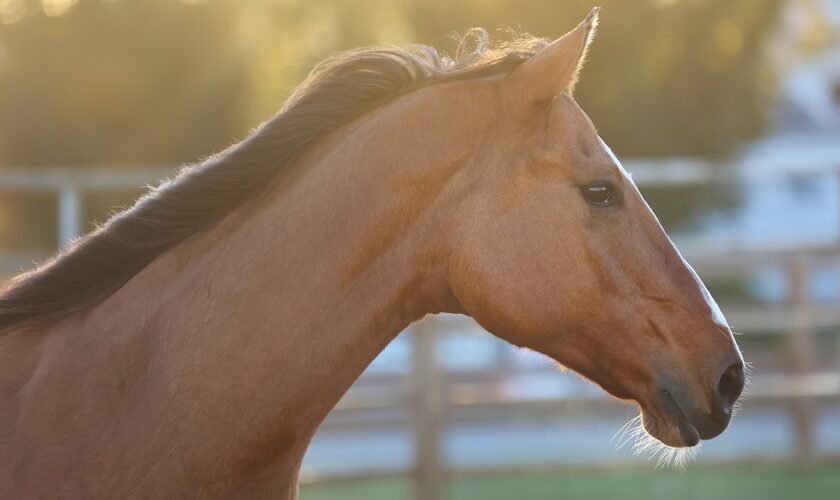
by Kristin Pitzer
The life of a performance horse can be unusual, compared to non-performance horses. Show horses tend to travel frequently, can have inconsistent meal and water times, and are often subjected to high pressure situations, such as making the finals at an upper-level event or competing multiple times in a day.
It comes as no surprise, then, that the stress of such a lifestyle can subject these horses to gut health issues. Not only can these problems put a damper on a horse’s career, but they can also become serious quickly and take time to overcome.
Quarter Horse News spoke with Thomas Kellerman, DVM, of Brazos Valley Equine Hospitals in Navasota, Texas, to get more information about performance horse gut health.
Forage Is Instrumental for Good Gut Health
Horses were built to graze and eat frequent small meals throughout the day, so their stomachs constantly produce acid to digest all the plant matter they ordinarily would consume. Most horses in training and showing programs don’t have the luxury of constant intake of food, though.
Instead, modern management practices usually require them to eat two large meals of grain a day, but if a horse’s diet is lacking in forage, it can create many health issues.
“Frequent intake of forage helps to maintain gastric health in particular,” Kellerman said. “Nutritionists typically recommend a minimum of 1.5 to 2% of a horse’s body weight be fed in quality forage on a dry matter basis per day. Ideally, that amount of forage should be split into at least two feedings per day.”
“Forage” could mean pasture, assuming the pasture has good grass and isn’t a dry lot or full of weeds; grass hays, like coastal, Bermuda or Timothy; or alfalfa hay.
While experts agree that horses generally require long-stem forage to slow overall consumption and increase the amount of fibrous bulk that moves through the gut, horses that have dental or respiratory issues, such as equine asthma, may not be able to handle it.
Providing these horses with hay pellets, cubes or beet pulp can help them meet their fiber needs while protecting their stomachs from acid.
Gastric Ulcers Are Common
Even if a horse is eating plenty of forage, there are other things, like the stress of traveling and showing, that can lead to stomach ulcers. These are erosions in the lining of the stomach, varying from small, superficial single lesions to multiple large defects.
It is estimated that 50 to 90% of horses have experienced a stomach ulcer at some point in their lives.
Horses with stomach ulcers may show signs of colic, ill-thrift or pain-related behavioral issues. Once diagnosed, they are typically treated with a 28-day course of omeprazole, which blocks stomach acid production. Some horses require up to 60 days of treatment, depending on the severity of the ulceration.
“There is very rapid turnover of the proton pumps, which is why we treat horses with diagnosed gastric ulcer disease daily to keep the stomach pH higher, or less acidic, than it normally would be without treatment,” Kellerman said.
“Horses can also develop ulceration in the glandular stomach, which is constantly exposed to gastric fluids. Horses that develop glandular disease are sometimes treated with sucralfate, which almost acts like a liquid bandage to coat the healing tissues, as well as misoprostol, which is a prostaglandin analogue to increase mucosal blood flow.”
Other Gut-Related Diseases Can Pose Problems
While stomach ulcers are a common gut problem in horses, they aren’t the only concern. Colic is another major issue. There are many things that can cause a horse to colic, but research shows that going for several hours without water, staying stalled without turnout, eating a diet that is high in grain and changing environments often — all things that affect show horses — can greatly increase the risk.
Colitis and inflammatory bowel disease also play an important role, especially in horses of performance age. Additionally, certain infectious diseases can affect the horse’s gut, along with parasites, inflammation and tumors. Any time your horse is acting abnormal warrants a call to your veterinarian, but if you see certain symptoms, it’s highly possible something in the gut is the culprit.
“Colic, anorexia, difficulty maintaining body condition, reaction to girthing and behavioral issues are all signs that would cause me to look at a horse’s gastric health,” Kellerman said.
Gut Health Extends Beyond the Stomach
When equestrians think of gut health, they tend to focus solely on the gastric aspects. After all, the stomach plays a large role in a horse’s well-being, and it’s also easy to visualize with a gastroscope, Kellerman said. But a horse’s gut health goes beyond the stomach.
“Every portion of the equine gut plays an important role in their overall health from nose to tail,” Kellerman said. “Even though the small intestine and colon are more difficult to directly examine, they still play a vital role in a horse’s health.
Issues such as right dorsal colitis from long term NSAID use, and infectious causes of colitis, such as Salmonella or Clostridial enteritis, can have a massive impact on horses if they develop diarrhea.”
Sand accumulation in the colon, which is often cleared through the use of psyllium supplementation, is common in some parts of the country and can lead to sand colic, chronic diarrhea and weight loss. Veterinarians are also discovering how the use of prebiotics and probiotics can support the horse’s large colon health.
A recent area of interest, Kellerman added, is the horse’s microbiome, or natural population of bacteria in their gastrointestinal system, and using polymerase chain reaction (PCR) testing to target individual therapies to specific horses.
Prevention Is the Best Plan for Performance Horses
You can’t completely prevent stress if your horse is frequently on the road traveling to shows or rodeos, but there are still management strategies you can utilize to prevent ulcers and other gastric diseases. Kellerman likes to give a preventative dose of UlcerGard to horses to help them mitigate the pressure of being on the road.
There are also products available on the market that help buffer stomach acid and chemically decrease the acid content of the stomach for a period of time. Keeping a supply of forage in front of your horse on the trailer and in his stall can also keep stomach acid from building up and creating sores.
When on the road, taking several short breaks to give water, rather than powering through the drive, may keep colic at bay. And, by allowing your horse to have mental breaks at shows, even if it’s just to hand graze for a few minutes or walk around to see other horses, you can keep his stress levels down and his mental health stable.
This article originally appeared on Quarter Horse News and is published here with permission.
There are more informative and entertaining articles in our section on Health & Education. While you're here be sure to check out our Curated Amazon Store.
- Using Ultrasound to Diagnose SI Joint Disease in Horses
- Hemp Hurd Bedding for Horses
- What Pasture Snacks Mean for Horse Health
- How would you help a rider who struggles with combinations?
- Descending Gymnastics: Why Ending Smaller Can Be Smarter
- Horse Management Survey Results: A Nutritionist’s Perspective
- Six Key Questions About Platelet-Rich Plasma for Horses
- Potomac Horse Fever
- Drinking Behavior of Horses: Six Facts About Water Intake
- Protein and Muscle Recovery for Performance Horses - an excerpt from Helping All Horses Live Healthier Lives
- Evaluating Horses for Back Pain
- Is Pasture Grazing Safe This Summer for Your Insulin-Resistant Horse
- Chewing Halters: A New Tool to Track Ingestive Behavior and Optimize Welfare
- Barn Construction: 7 Principles to Reduce Fire Risk
- Top 3 Causes of Barn Fires
- Rope Halter Safety and Adjustment with Julie Goodnight
- Crafting Diets for Easy and Hard Keeper Horses - an excerpt from Helping All Horses Live Healthier Lives
- How Horse Show Culture Has Changed (and why it’s worth preserving)
- Listening Beyond Words: The Wisdom of Horses
- More than ‘Four on the Floor’ with Equine Guelph Horse Trailer Safety Course
Our Mission — Serving the professional horse person, amateur owners, occasional enthusiasts and sporting interests alike, the goal is to serve all disciplines – which often act independently yet have common needs and values.
Equine Info Exchange is totally comprehensive, supplying visitors with a world wide view and repository of information for every aspect related to horses. EIE provides the ability to search breeds, riding disciplines, horse sports, health, vacations, art, lifestyles…and so much more.
EIE strives to achieve as a source for content and education, as well as a transparent venue to share thoughts, ideas, and solutions. This responsibility also includes horse welfare, rescue and retirement, addressing the needs and concerns of all horse lovers around the world. We are proud to be a woman-owned business.






